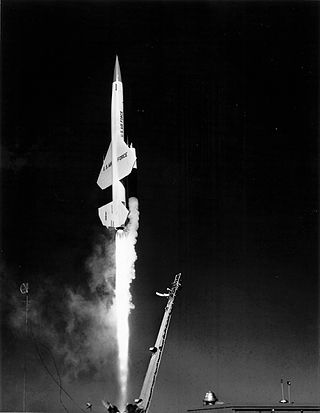
The Boeing CIM-10 Bomarc was a supersonic ramjet powered long-range surface-to-air missile (SAM) used during the Cold War for the air defense of North America. In addition to being the first operational long-range SAM and the first operational pulse doppler aviation radar, it was the only SAM deployed by the United States Air Force.
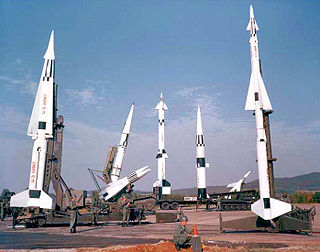
Project Nike was a U.S. Army project, proposed in May 1945 by Bell Laboratories, to develop a line-of-sight anti-aircraft missile system. The project delivered the United States' first operational anti-aircraft missile system, the Nike Ajax, in 1953. A great number of the technologies and rocket systems used for developing the Nike Ajax were re-used for a number of functions, many of which were given the "Nike" name . The missile's first-stage solid rocket booster became the basis for many types of rocket including the Nike Hercules missile and NASA's Nike Smoke rocket, used for upper-atmosphere research.

White Sands Missile Range (WSMR) is a United States Army military testing area and firing range located in the US state of New Mexico. The range was originally established in 1941 as the Alamogordo Bombing and Gunnery Range, where the Trinity test site lay at the northern end of the Range, in Socorro County near the towns of Carrizozo and San Antonio. It then became the White Sands Proving Ground on 9 July 1945.
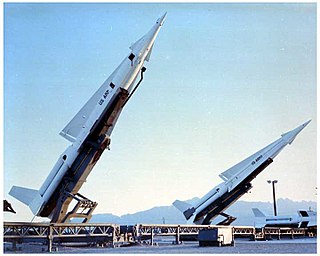
The Nike Hercules, initially designated SAM-A-25 and later MIM-14, was a surface-to-air missile (SAM) used by U.S. and NATO armed forces for medium- and high-altitude long-range air defense. It was normally armed with the W31 nuclear warhead, but could also be fitted with a conventional warhead for export use. Its warhead also allowed it to be used in a secondary surface-to-surface role, and the system also demonstrated its ability to hit other short-range missiles in flight.

SF-88 is a former Nike Missile launch site at Fort Barry, in the Marin Headlands to the north of San Francisco, California, United States. Opened in 1954, the site was intended to protect the population and military installations of the San Francisco Bay Area during the Cold War, specifically from attack by Soviet bomber aircraft.
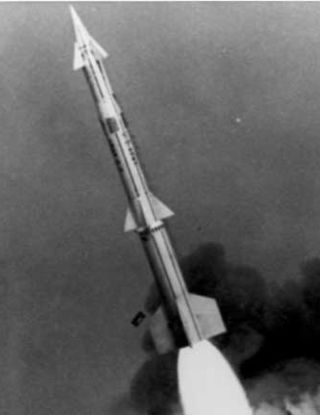
The LIM-49 Spartan was a United States Army anti-ballistic missile, designed to intercept attacking nuclear warheads from intercontinental ballistic missiles at long range and while still outside the atmosphere. For actual deployment, a five-megaton thermonuclear warhead was planned to destroy the incoming ICBM warheads. It was part of the Safeguard Program.

Fort Hancock is a former United States Army fort at Sandy Hook in Middletown Township, New Jersey. The coastal artillery base defended the Atlantic coast and the entrance to New York Harbor, with its first gun batteries operational in 1896. The fort served from then until 1950 as part of the Harbor Defenses of New York and predecessor organizations. Between 1874 and 1919, the adjacent US Army Sandy Hook Proving Ground was operated in conjunction with Fort Hancock. It is now part of Fort Hancock Memorial Park. It was preceded by the Fort at Sandy Hook, built 1857–1867 and demolished beginning in 1885.

Fort MacArthur is a former United States Army installation in San Pedro, Los Angeles, California. A small section remains in military use by the United States Air Force as a housing and administrative annex of Los Angeles Air Force Base. The fort is named after Lieutenant General Arthur MacArthur. His son, Douglas MacArthur, would later command American forces in the Pacific during World War II.

The Nike Missile Site HM-69 is a former Nike-Hercules missile base, now listed as a historic site west of Homestead, Florida, United States. It is located on Long Pine Key Road in the Everglades National Park. The site with 22 buildings opened in 1964 and closed in 1979 when it was turned over to the National Park Service.

Fort Tilden, also known as Fort Tilden Historic District, is a former United States Army installation on the coast in the New York City borough of Queens. Fort Tilden now forms part of the Gateway National Recreation Area, and is administered by the National Park Service.

A missile launch facility, also known as an underground missile silo, launch facility (LF), or nuclear silo, is a vertical cylindrical structure constructed underground, for the storage and launching of intercontinental ballistic missiles (ICBMs), intermediate-range ballistic missiles (IRBMs), medium-range ballistic missiles (MRBMs). Similar facilities can be used for anti-ballistic missiles (ABMs).
Dorseyville is an unincorporated suburb of Pittsburgh located in Indiana Township, Allegheny County, Pennsylvania, United States.
The Martin AN/FSG-1 Antiaircraft Defense System, better known as Missile Master, was an electronic fire distribution center for United States Army surface-to-air missiles. It aimed to computerize Cold War air defense (AD) command posts from manual plotting board operations to automated command and control.

The Western Electric System 1393 Radar Course Directing Central (RCDC) was a Cold War complex of radar/computer systems within the overall Improved Nike Hercules Air Defense Guided Missile System. The RCDC was installed at the "battery control areas" of ~5 hectares each which was for commanding a nearby missile Launching Area (LA), firing a missile from the LA, and guiding a launched missile to a burst point near an enemy aircraft.
The Arlington Heights Army Air Defense Site was a Project Nike Missile Master site near Chicago, Illinois. It operated from 1960 until 1968.
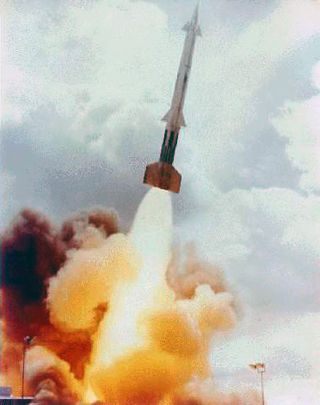
Nike Zeus was an anti-ballistic missile (ABM) system developed by the United States Army during the late 1950s and early 1960s that was designed to destroy incoming Soviet intercontinental ballistic missile warheads before they could hit their targets. It was designed by Bell Labs' Nike team, and was initially based on the earlier Nike Hercules anti-aircraft missile. The original, Zeus A, was designed to intercept warheads in the upper atmosphere, mounting a 25 kiloton W31 nuclear warhead. During development, the concept changed to protect a much larger area and intercept the warheads at higher altitudes. This required the missile to be greatly enlarged into the totally new design, Zeus B, given the tri-service identifier XLIM-49, mounting a 400 kiloton W50 warhead. In several successful tests, the B model proved itself able to intercept warheads, and even satellites.

The Nike Ajax was an American guided surface-to-air missile (SAM) developed by Bell Labs for the United States Army. The world's first operational guided surface-to-air missile, the Nike Ajax was designed to attack conventional bomber aircraft flying at high subsonic speeds and altitudes above 50,000 feet (15 km). Nike entered service in 1954 and was initially deployed within the United States to defend against Soviet bomber attacks, though it was later deployed overseas to protect US military bases, and was also sold to various allied militaries. Some examples remained in use until the 1970s.
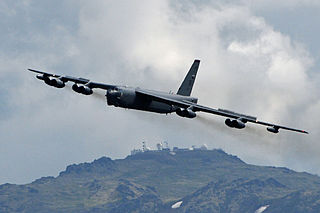
The Nike Site Summit is a historic military installation of the United States Army in Anchorage Borough, Alaska. The site, located in the Chugach Mountains overlooking Joint Base Elmendorf–Richardson, is the location of one of the best-preserved surviving Nike-Hercules missile installations in the state. The site's structures include a battery control area, a missile launch area, and several magazines. Units of the 43rd Air Defense Artillery Regiment, USARAL Artillery Group, United States Army Alaska, would have garrisoned the site. The site was built in 1957-58 and equipped with missiles in 1959. The site was in active service defending the United States from the threat of Soviet air strikes until it was decommissioned in 1979, after which sensitive militarily equipment was removed. The U.S. Army maintained the site into the 1980s before abandoning it. The site was listed on the National Register of Historic Places in 1996. A local non-profit group, Friends of Nike Site Summit, is actively attempting to preserve the site.

Nike-X was an anti-ballistic missile (ABM) system designed in the 1960s by the United States Army to protect major cities in the United States from attacks by the Soviet Union's intercontinental ballistic missile (ICBM) fleet during the Cold War. The X in the name referred to its experimental basis and was supposed to be replaced by a more appropriate name when the system was put into production. This never came to pass; in 1967 the Nike-X program was canceled and replaced by a much lighter defense system known as Sentinel.





























